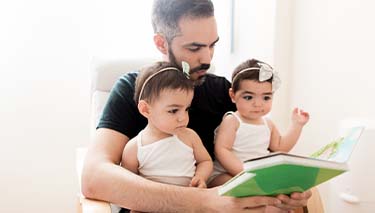Fraternal twins are just like any other brothers and sisters in the same family who share the same biological parents. The only difference is that they just happen to have been conceived in the same month and be sharing their mother’s uterus during the same pregnancy.
Other names for fraternal twins are non-identical or dizygotic twins as they form from two completely separate eggs and sperm. This is different to identical or monozygotic (one egg) twins who form as a result of one fertilised egg splitting into two identical little people.
Fraternal twins tend to run in families – the tendency for hyper ovulation during the same menstrual cycle is a genetic trait. For women whose grandmothers, mothers, aunts or sisters had fraternal twins, the likelihood for them to have fraternal twins is higher. Importantly, if a mother is a fraternal twin, she is more likely to have fraternal twins herself.
Fraternal twins share around 50% of their genetic makeup. This is no more than other siblings with the same biological parents.
How do fraternal twins fit?
Fraternal twins have their own little space in their mother’s uterus and are surrounded by their own amniotic membranes. They do not share a placenta and each has their own. Unlike identical twins, fraternal twins can be different genders or the same: e.g. two boys, two girls or a boy and a girl. It seems that the odds are almost equal for fraternal twins to be either the same gender or opposites.
How do fraternal twins happen?
Around 2 in every 100 births are fraternal twins and of the total numbers of twins that are born, 2/3 are fraternal. By far, the rate of fraternal twins outweighs identical or monozygotic twins. We are seeing more fraternal twins since the widespread acceptance of fertility treatments.
Very rarely, a mother who is already pregnant releases another egg in the same month which is then fertilised by a separate sperm. This is a phenomenon known as superfetation. But this can
only happen a few weeks after the first baby has been conceived. This may account for the reason why at birth, one fraternal twin can appear much larger and more mature than the other one.
It is also possible for a woman to conceive fraternal twins with two different biological fathers. This can happen when she is already pregnant with one baby and she ovulates again. A simultaneous pregnancy occurs when the second egg is fertilised by a sperm from a different partner.
It is also possible for triplets to consist of a set of identical or fraternal twins plus one singleton. If the twins are identical it can be very clear that they are monozygotic, but if they are fraternal, they may appear like any other sibling. This is why the placenta and membranes are examined very carefully and sometimes sent away for pathology assessment. The placenta and membranes will often provide answers, along with DNA testing of each baby, when it’s not always clear whether twins are fraternal or identical.
What increases the odds of having fraternal twins?
- When a mother has been having assisted reproductive technology, in particular medication which increases the number of eggs she is releasing.
- If a mother is a fraternal twin herself she has around a 10% chance of having non-identical/fraternal twins herself.
- If a mother has already had one set of fraternal twins, she is more likely to have another set.
- The same as for any other conception – having a lot of sex in fertile times during your cycle will help to increase your chances.
- The more babies a woman has, the higher her chances of conceiving with fraternal twins. Couples who limit the number of children they have automatically reduce their chances of having twins.
- The older a mother is when she conceives, the greater the likelihood of her having fraternal twins. Younger mothers in their 20’s do not have the same chances of having fraternal twins as those who are in their 30’s and 40’s. Mothers who are over the age of 35 have twice the likelihood of conceiving with fraternal twins.
- Women who are of black African descent – their chances of having fraternal twins is highest of all the races. Asian women tend to have the least chances of having fraternal twins.
- Women who eat a diet rich in yams and sweet potatoes tend to increase their chances of having fraternal twins.
- Some studies claim that the taller a woman is, the greater the likelihood of her conceiving with fraternal twins.
- There is still some debate on whether a father’s genetic influence plays any part in his daughter’s chances of conceiving with twins. If his mother was a twin, or there was a maternal tendency for twins on his side, then perhaps he does play a role in his daughter’s tendency for hyper ovulation. This may be where the saying that “twins skip a generation” holds some truth. Obviously, fathers do not ovulate but their genetic influence of twinning on his side of the family may have a flow on effect to his daughters.
What do fraternal twins look like?
At birth it can be very difficult to tell fraternal twins apart. Sometimes it’s not until there are two placentas identified that that it is clear that the twins are fraternal. But remember, identical twins can also have two placentas, depending on the stage of cell multiplication that they divided.
But as they mature, each fraternal twin develops their own unique appearance and often turns out to be no more similar to look at than any other siblings in the same family.
Alternately, fraternal twins can appear completely different to each other right from birth, with different hair colouring, facial features, sizes and birth weights. If they are very alike, even parents can have difficulty telling them apart.
How will I know if I’m pregnant with fraternal twins?
Some women suspect they are pregnant with twins long before it is confirmed scientifically. Interestingly, mothers of twins will often say they – always knew? they were going to have twin babies; that they dreamt they would have them, or for a long time felt sure that twins were in their future. You won’t be sure unless you are experiencing very severe pregnancy symptoms or you have had an ultrasound which identified two embryos. But it’s not always clear in the very early stages if twins are identical or fraternal.
If you come from a family where fraternal twins are common, you are likely to have inherited the twin gene yourself. You will be aware that you have higher than average chances of conceiving with fraternal twins yourself.
Twins can be diagnosed during a 12 week scan, although they may be detected as early as 6 weeks if two sacs can be seen. By 12 weeks a mother can be told if she is carrying identical or fraternal twins.
Identical twins are surrounded by only two thin layers of amnion, the inner sac lining. But fraternal twins are surrounded by both the two layers of amnion as well as two outer layers of membranes, known as the chorion. Fraternal twins each have their own placenta.
What are the risks of having fraternal twins?
The risks are very similar to those as when having identical twins, though without the same potential risk of having twin to twin transfusion.
An increased likelihood of:
- Caesarean section delivery.
- Prematurity and low birth weight as a result of intra uterine growth restriction.
- Pregnancy induced hypertension.
- Gestational Diabetes.
- Placenta Praevia.
- A longer postnatal recovery time.
Last Published* May, 2024
*Please note that the published date may not be the same as the date that the content was created and that information above may have changed since.


















